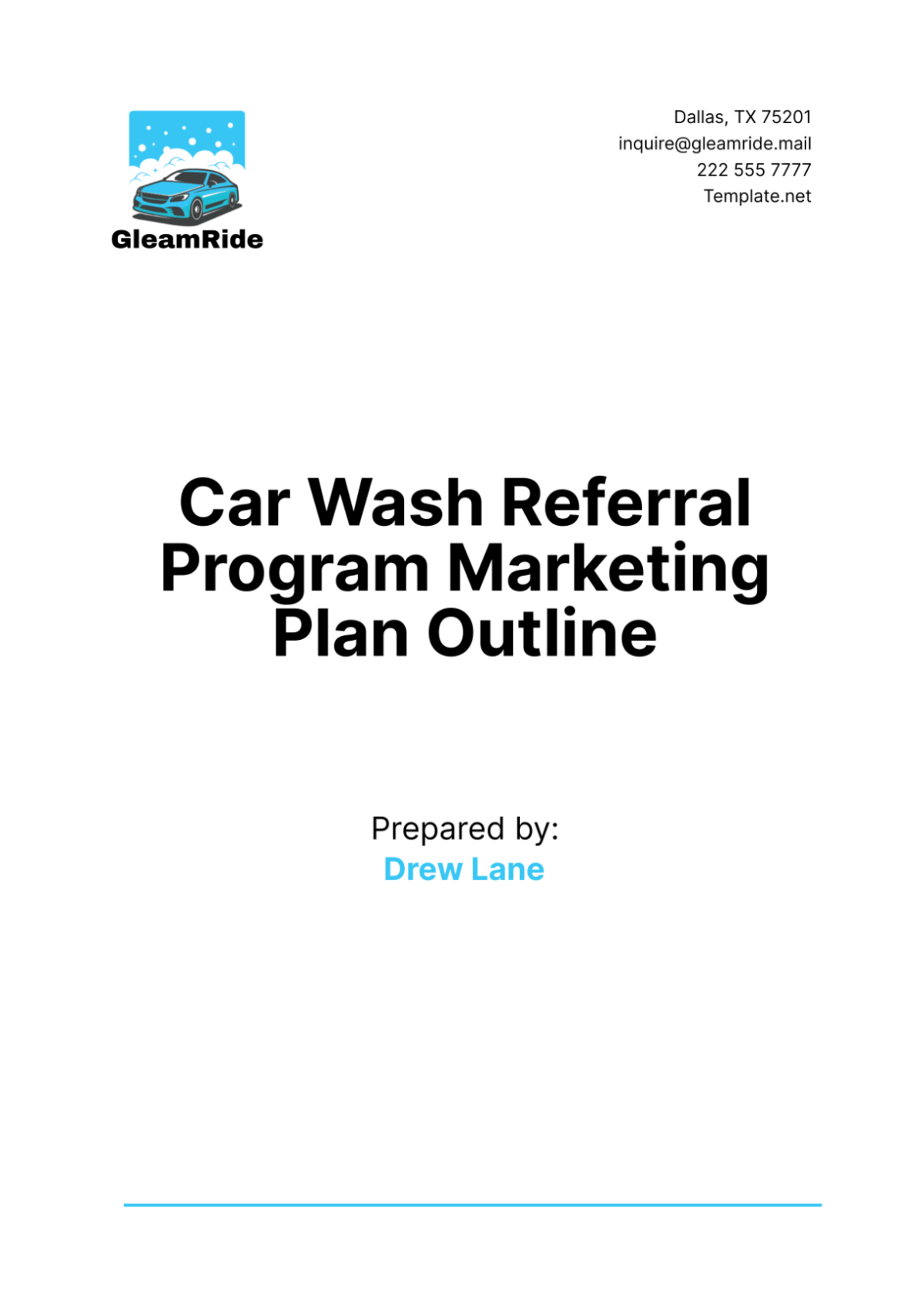Free Car Wash Referral Program Marketing Plan Outline

I. Executive Summary
(The executive summary provides an overview of the Car Wash Referral Program Marketing Plan for [Your Company Name]. This section highlights the objectives, target market, and key strategies to attract and retain customers through the referral program. The summary also outlines the expected outcomes and the overall impact on the business.)
II. Introduction
(The introduction details the purpose and significance of the Car Wash Referral Program for [Your Company Name]. It explains how the program will encourage existing customers to refer new clients, leading to increased customer acquisition and loyalty. Additionally, it provides a brief background on the car wash industry and the competitive landscape.)
A. Background
(This subsection offers an insight into the car wash industry, including current trends and market conditions. It also discusses the competitive environment and how [Your Company Name] positions itself within the market.)
B. Purpose
(The purpose section clarifies the objectives of implementing a referral program. It explains how the program aims to leverage word-of-mouth marketing to enhance customer acquisition and retention.)
III. Market Analysis
(The market analysis provides a detailed examination of the target market for the referral program. It includes demographic and psychographic profiles of potential customers, market needs, and buying behaviors. This section helps in understanding the audience and tailoring the referral program to meet their preferences.)
A. Target Market
(This subsection identifies the primary and secondary target markets for the referral program. It includes demographic details such as age, gender, income level, and geographic location.)
B. Market Needs
(The market needs section explores the specific needs and preferences of the target audience. It highlights the importance of a clean car, convenience, and value for money.)
C. Competitive Analysis
(A thorough competitive analysis outlines the strengths and weaknesses of competitors' referral programs. It identifies opportunities for differentiation and positioning [Your Company Name]'s referral program as a superior option.)
IV. Program Design
(The program design section outlines the structure and components of the referral program. It includes details on incentives, eligibility criteria, and the process for referring new customers. This section ensures that the program is attractive and easy to understand.)
A. Incentives
(This subsection describes the rewards and incentives offered to customers who refer new clients. It includes options such as discounts, free services, or loyalty points.)
B. Eligibility Criteria
(The eligibility criteria outline who can participate in the referral program. It specifies the conditions that must be met by both the referrer and the referred customer.)
C. Referral Process
(The referral process section explains the steps customers need to follow to refer others and claim their rewards. It includes details on how to track referrals and the methods for distributing incentives.)
V. Marketing Strategies
(This section details the marketing strategies to promote the referral program. It includes both online and offline tactics to reach the target audience effectively. The strategies are designed to create awareness and encourage participation in the program.)
A. Digital Marketing
(Digital marketing strategies involve using online channels such as social media, email marketing, and search engine optimization (SEO) to promote the referral program. This subsection outlines specific tactics for each channel.)
B. Traditional Marketing
(Traditional marketing strategies include offline methods such as flyers, posters, and in-store promotions. This subsection explains how these methods will be used to complement digital efforts and reach a broader audience.)
C. Partner Collaborations
(Partner collaborations involve working with local businesses and influencers to promote the referral program. This subsection describes potential partnerships and how they can enhance the program's reach and credibility.)
VI. Implementation Plan
(The implementation plan provides a step-by-step guide to launching the referral program. It includes timelines, responsibilities, and resources required to ensure a smooth rollout. This section ensures that the program is executed efficiently and effectively.)
A. Timeline
(The timeline outlines the key milestones and deadlines for implementing the referral program. It includes pre-launch, launch, and post-launch phases.)
B. Responsibilities
(This subsection details the roles and responsibilities of team members involved in the referral program. It ensures that everyone understands their tasks and contributes to the program's success.)
C. Budget
(The budget section provides an estimate of the costs associated with implementing and maintaining the referral program. It includes expenses for marketing, incentives, and administrative tasks.)
VII. Evaluation and Monitoring
(The evaluation and monitoring section outlines the methods for tracking the success of the referral program. It includes key performance indicators (KPIs), data collection methods, and regular review processes to ensure continuous improvement.)
A. Key Performance Indicators (KPIs)
(This subsection identifies the metrics used to measure the program's effectiveness. It includes KPIs such as the number of referrals, customer acquisition rate, and return on investment (ROI).)
B. Data Collection
(Data collection methods involve gathering information on customer participation and feedback. This subsection explains the tools and techniques used to collect and analyze data.)
C. Review Process
(The review process section outlines the regular intervals at which the program's performance will be evaluated. It includes steps for making necessary adjustments to improve the program's outcomes.)
VIII. Conclusion
(The conclusion summarizes the key points of the Car Wash Referral Program Marketing Plan. It reiterates the objectives, strategies, and expected outcomes. This section emphasizes the importance of the referral program in achieving long-term business growth and customer satisfaction for [Your Company Name].)
- 100% Customizable, free editor
- Access 1 Million+ Templates, photo’s & graphics
- Download or share as a template
- Click and replace photos, graphics, text, backgrounds
- Resize, crop, AI write & more
- Access advanced editor
Boost your customer base with Template.net's customizable and editable Car Wash Referral Program Marketing Plan Outline Template. Leverage the Ai Editor Tool to tailor this template to your requirements. Create a successful referral program, encouraging customers to refer friends and family, thereby increasing your business's reach and revenue.





























